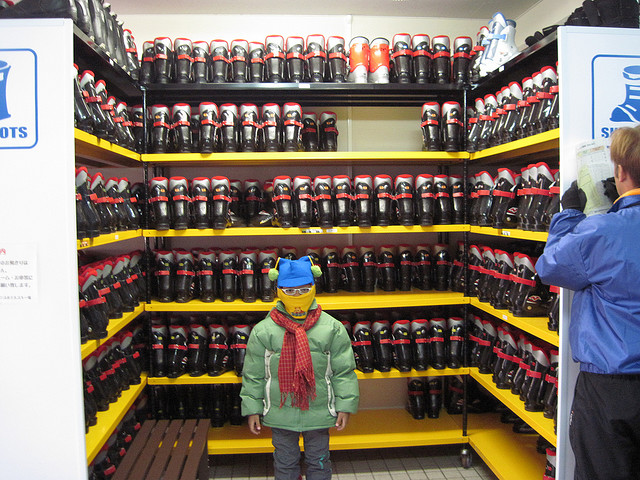
When a new skier’s legs look wobbly, and he’s really exerting himself and nothing much is happening, too-big boots are often the problem. The only remedy is to return to the rental shop and demand a smaller ski boot. A person can go one-half size smaller by choosing the same shell boot with a thicker liner or go down one shell size.
- Basic rule…get boots as small as possible without discomfort and buckle them as tightly as possible without discomfort. As always, nothing inside the boot cuff except one pair of medium thickness socks–no long undies, snow cuff, pants cuff, etc. It is OK if the toes lightly touch the end of the boot when the skier is standing in the skiing position (and probably a good thing). -SoftSnowGuy
The following chart is taken from the wiki Boot Fitting: Which Boot Will Work for Me. *Note Men’s U.S. Size is on line 1 and Women’s U.S. Size is on line 2. “Mondo” is boot size in centimeters and is a more accurate and standardized way of asking for a properly sized boot.
The chart is from Garmont and differs from most size conversion charts in that it shows a recommended Mondo size nearly one-size smaller than nearly all other boot manufacturer’s charts. The bootfitters have considered this chart to be a more accurate reference for sizing, although it should not be a substitute for actually trying on a boot and getting expert fitting assistance.
 The Bootfitting Terms and Glossary Wiki will also help to understand terms like “Shell-Fitting” and the parts of the boot. For example:
The Bootfitting Terms and Glossary Wiki will also help to understand terms like “Shell-Fitting” and the parts of the boot. For example:
Shell Fit
A shell-fit is when the technician removes the boot liner and has the customer place their foot in the shell and slide it forward until the toes begin to touch. Then the technician will shine a light to observe the clearance to the spine of the shell or slide his hand down the back and see how much room is behind the heel. There should be enough space there to fit 1 to 2 fingers. This is the best way to determine if the boot is the right length for you. A performance fit is 5 to 10 mm (one finger width), a recreational fit is up to 25 mm (2.5 cm).
Shell fit is also useful for determining lateral and instep clearances and marking where corrections need to be made to the shell. This may be done with the footbed on the bootboard. Shell Fitting is important because ultimately all liners compact and it is common to purchase a boot too large based on trying the boot with the liner. Liners may be short-lasted or not conform to the shell fit as they will after several days of skiing.
Rudy Herman
 Your Privacy Choices
Your Privacy Choices
 The
The